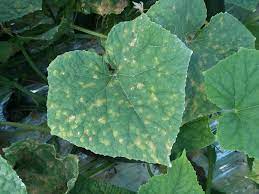
Cucurbit downy mildew disease was identified this week in South Carolina, according to the The South Carolina Grower. The disease was observed in a cucumber field in Bamberg County.
Clemson Extension reminds producers to make fungicide applications every seven days. Any stretch longer than this increases the potential that the disease will spread.
Recommended fungicides for cucumbers include Omega (Fluazinam, 7-day post-harvest interval in cucumbers), Bravo (chlorothalonil), Ranman (Cyazofamid), Presidio (fluopicolide), Orondis Opti (Oxathiapiprolin and clorothalonil; never use Orondis ultra in cucumbers), Elumen (Ethaboxam) and Gavel (Zoxamide and Mancozeb).
Recommended fungicides for cantaloupes include Ranman (Cyazofamid), Presidio (fluopicolide), Orondis Opti (Oxathiapiprolin and clorothalonil; never use Orondis ultra in cantaloupes), Elumen (Ethaboxam), Gavel (Zoxamide and Mancozeb) and Manzate (Mancozeb).
Recommended fungicides for squash and watermelons include Ranman (Cyazofamid), Orondis Opti (Oxathiapiprolin and clorothalonil), Orondis Ultra (Oxathiapiprolin and mandipropamid), Gavel (Zoxamide and Mancozeb) and Manzate (Mancozeb). Squash and watermelon are likely not at risk for downy mildew, since the squash strain has not moved out of South Florida.
Orondis applications should be just one-third of the spray program. Only one should be for Orondis if a grower makes one to five applications. If a producer makes between six to eight applications, then two can be for Orondis. However, only one application of Orondis should be made per cucumber crop.









